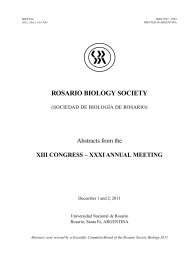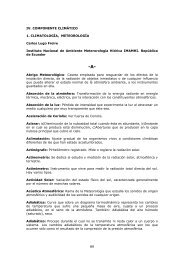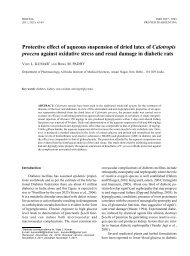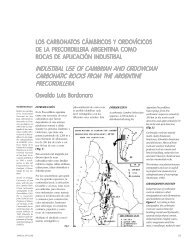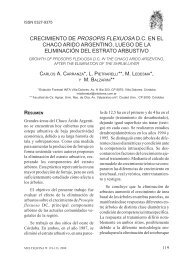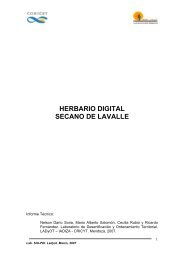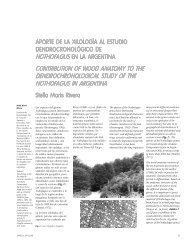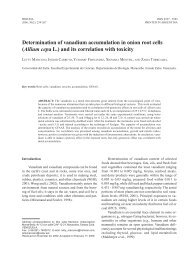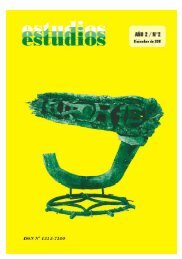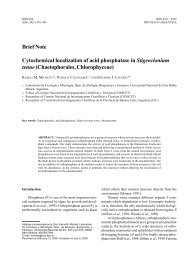XXII Annual Scientific Meeting, Tucuman Biology Society ...
XXII Annual Scientific Meeting, Tucuman Biology Society ...
XXII Annual Scientific Meeting, Tucuman Biology Society ...
Create successful ePaper yourself
Turn your PDF publications into a flip-book with our unique Google optimized e-Paper software.
204 ABSTRACTS<br />
153.<br />
DETECTION OF VIABLE NON-CULTURABE Vibrio cholerae<br />
O1 (NCVC) FROM RIVERS IN TUCUMAN, ARGENTINA<br />
Silva C, Aulet O, De Allori CG, Cangemi R, Cecilia M.<br />
Bacteriol., Fac Bqca,Qca,Fcia y Biotec., UNT. CP:4000.<br />
Bacteria can use a variety of adaptive strategies to survive in the<br />
environment. The temperature, light, evaporation and plankton can<br />
affect the survival of microorganisms regarding their persistence<br />
or ability to cause diseases. V.cholerae belongs to this group of<br />
bacteria. In Tucumán the bacterium was sporadically isolated associated<br />
with diarrhea. Due to its capacity to colonize sweet water<br />
the objective of this study was to detect V. cholerae (NCVC) using<br />
immunofluorescence (IF) to find environmental reservoirs, assessing<br />
rivers in Tucumán. Three preestablished spots of the rivers Lules<br />
(1) and Salí [Banda (2) and north canal (3)] were sampled during<br />
the four seasons. The filter membranes for water were suspended<br />
in 8 ml of PBS. To 1 ml of the PBS suspension and 1 ml of phyto<br />
and zooplankton 100 μl of ANY medium was added and the mixtures<br />
were incubated at 37°C for 6h. Then 4% formaldehyde was<br />
added. Detection of Vibrio O1 NCVC using IF DFA-DVC (New<br />
Horizons Diagnostics Lab, Columbia, MD, USA) Samples were<br />
fixed on slides and reagent was added. Were incubated in a humid<br />
chamber at 37°C for 30 min without light. Then they were washed<br />
with PBS and examined. Vibrio O1 NCVC was detected in all the<br />
samples with highest numbers in summer. It is necessary preventative<br />
measures to avoid transformation of the rivers into a source of<br />
infection.<br />
154.<br />
MICROBIOLOGICAL CONTROL OF TEA FROM SUPER-<br />
MARKET SHELVES<br />
Porcel N, Castillo M.<br />
Cátedra de Bacteriología. Fac. de Bioq, Qca y Fcia. UNT. Ayacucho<br />
491. CP: 4000.<br />
Tea is a pleasant, popular, economical, safe and socially accepted<br />
beverage, which is consumed daily by millions of people around<br />
the world. It is obtained through an infusion of leaves from the<br />
Camellia sinensis plant. This study make an assessment of the microbiological<br />
quality of tea commercialized in S. M de Tuc, Arg, in<br />
2004. Ten different tea brands, 5 coming in teabags and 5 in leaves,<br />
were analyzed on the following: Total Mesophilic Aerobic Bacteria<br />
(TMAB) in nutritious agar medium, Fungi and Yeasts (F+Y) in<br />
fungus and yeast medium supplemented with chloramphenicol,<br />
Total Coliform Bacteria at 37°C (C37) in Mac Conkey broth (most<br />
probable number technique; MPN/100 ml), Fecal Coliform Bacteria<br />
at 45°C (C45) in brilliant green broth, Presence or Absence of<br />
Escherichia coli (EC) and Salmonella and Shigella (S/Sh) in lactose<br />
broth, selenite and tetrathionate Salmonella Agar. TMAB figures<br />
were between 2x10 2 and 2x10 4 cfu/ml. 4 samples showed values<br />
for C37 within standard limits, whereas the 6 remaining were<br />
above standard. Fungi varied between 2x10 and 3x10 3 and yeasts<br />
between 5x10 and 3.1x10 3 . C45, EC and S/Sh were not detected.<br />
Although most microbiological parameters of the commercial teas<br />
were generally acceptable, presence of C37 in 60% of the cases is<br />
a potential risk of appearance of pathogens. Consequently, periodic<br />
controls should be intensified, so as to guarantee and assure<br />
good quality manufacturing.<br />
BIOCELL 30(1), 2006<br />
155.<br />
INDUCTION OF AN EXPERIMENTAL MODEL OF AU-<br />
TOIMMUNE DISEASE BY INOCULATION OF THE RNP<br />
ANTIGEN<br />
Haro MI, Valdéz JC, Valverde M, Marsiglia R.<br />
Histology Department, Faculty of Medicine, Universidad Nacional<br />
de Tucumán. E-mail: mariaisabelharo@yahoo.com.ar<br />
Mixed connective tissue disease (MCTD) is an illness of autoimmune<br />
etiology with overlapping signs and symptoms of lupus,<br />
dermatomyositis, rheumatoid arthritis and scleroderma and is associated<br />
with anti-RNP antibodies. Objective: to induce an experimental<br />
model for MCTD by inoculation with ribonuclearprotein<br />
(RNP) antigen. Materials and Methods: 18 BALB/c mice of 40<br />
weeks were inoculated as followed: group I) was injected with<br />
100μg of RNP SC in complete Freund’s adjuvant and then weekly<br />
with 50 μg in incomplete adjuvant until completing four inoculations;<br />
group II) received 50 μg of RNP IP in complete Freund’s<br />
adjuvant, continuing weekly with 50 μg until. Control mice were<br />
inoculated with Freund’s adjuvant. Results: 8/18 mice shown visceral<br />
hypertrophy; 4/18 alopecia; 2/18 corneal opacity; 2/18 malnutrition;<br />
4/18 arthritis. There were no differences in function of<br />
sex or inoculation route. No control mice shown signs or symptoms<br />
of MCTD. Conclusion: our findings in inoculated mice with<br />
RNP in Freund’s adjuvant were consistent with clinical features<br />
described in patients with MCTD.<br />
156.<br />
HISTOPATHOLOGICAL FINDINGS IN LUNG OF AN<br />
EXPERIMENTAL MODEL OF AUTOIMMUNE DISEASE<br />
Valverde M, Uñates J, Alabarse G, Núñez JM, Carmona L, Haro MI.<br />
Histology Department, Faculty of Medicine, Univ. Nacional de<br />
Tucumán. E-mail: martahvb@hotmail.com<br />
Mixed connective tissue disease (MCTD) was considered a pathology<br />
of benign evolution but the clinical manifestations are now<br />
well-known where the histopathological changes are wide and diverse.<br />
Objective: to describe the histopathological findings in lung<br />
using an experimental model of MCTD. Material and Methods: 18<br />
BALB/c mice, of both sexes and 40 weeks of age were inoculated<br />
with ribonuclearprotein (RNP) in Freund’s adjuvant (9 mice IP and<br />
9 SC) in four doses, according to established protocol. Control<br />
group: mice were only injected with Freund’s adjuvant. After the<br />
third month of last inoculation mice were sacrificed and the organs<br />
were processed (H-E and Gallego’s staining). Results: the most<br />
characteristic findings were: lymphoid interstitial pneumonitis, interstitial<br />
fibrosing pneumonitis and granulomas in subpleural area.<br />
Conclusions: the histopathological findings in the lung of the mice<br />
inoculated with the RNP antigen would be similar to lesions described<br />
in patients with MCTD.



